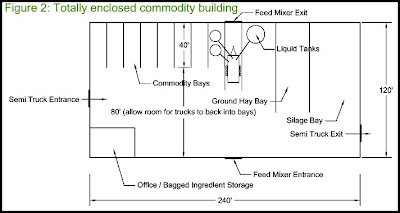The goal of every dairy is profitability so most producers regularly evaluate their operations to find ways to reduce input costs. In these evaluations, one cost is frequently overlooked despite its significant impact on the bottom line. Here are a few facts about this "mystery" cost (Harner):
- It occurs daily on most dairies.
- It may account for 15-20% of your total feed cost.
- Its cost is frequently ignored and considered "normal."
- Reducing it by 50% can save about $100 per cow annually.
- Its losses can be reduced in little to no cost ways.
- Take moisture into account when formulating a ration as storage and rain/snow can alter moisture and dry matter content.
- Lowering a curtain or flexible door at night or after feeding can prevent significant ingredient losses due to the elements - rain, snow, and wind.
- Consider pre-weighing ingredients with a smaller stationary mixer prior to transferring the feed into a larger mixer or feed delivery wagon to help increase mixing accuracy.
- Make sure your scale is accurately weighing ingredients. Scale accuracy is based on the load cells used to weigh the mixer box. Harner identifies two basic scale errors: scale inconsistency and consistent weight addition or subtraction. Both can lead to over or underfeeding of ingredients, among other problems.
- Use windbreaks around three-sided commodity buildings to reduce shrink and minimize soil and foreign material from accumulating in the feed center area.
Illustrations of Effective Feed Center Designs
Figure 1 Advantages: Windbreak located at least 4 times the height of the windbreak away from the feed center can create a snow dump area. By modifying one side of a row of commodity bays, this design can include a second building to provide additional wind protection and/or a place to store additional commodities.
Figure 2 Advantages: The totally enclosed commodity building minimizes weather-related shrinkage losses. Make sure building width is large enough to accommodate semi-trucks delivering ingredients.
Figure 3 Advantages: This feed center provides room around the stationary mixer to use micro ingredient and liquid tanks. According to Harner, "Stationary mixers enable more hopper bottom tanks with automated handling equipment to be used for low-inclusion-rate ingredients and liquids." Close proximity of commodity bays to mixer provides adequate time to secure individual ingredients. This design also minimizes losses due to weather conditions.
Sources: "Efficient feed center design" article by J.P. Harner, J.F. Smith, M.J. Brouk, and B.J. Bradford, Kansas State University, Department of Animal Sciences and Industry. Western Dairy News, June 2011 issue.
"Shrink the Shrinkage" article by Catherine Merlo. Dairy Today, May 2011 issue.
Experience time, labor, feed, and fuel savings with a Patz Vertical Mixer!
SEEING IS BELIEVING!
"This is our first mixer. We save a lot of labor and our feeding is more accurate. We were just guessing before." --Derrick Vagts and Dennis Linderbaum of Ossian, IA |
Click here to view more Customer Success Stories!
The full Patz Vertical Mixer Series features trailer, stationary, and truck mount units with mixing capacities from 140-1,580 cu. ft.!




No comments:
Post a Comment